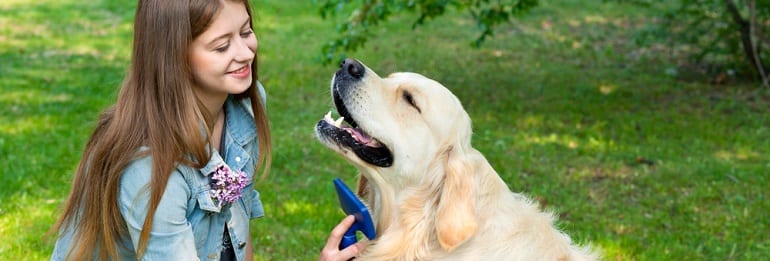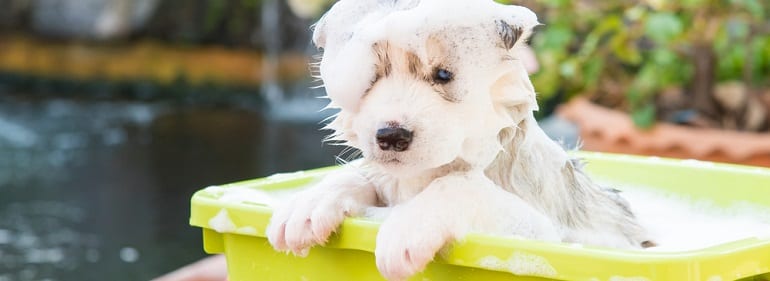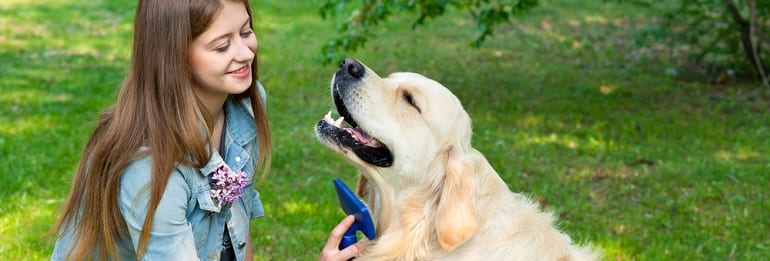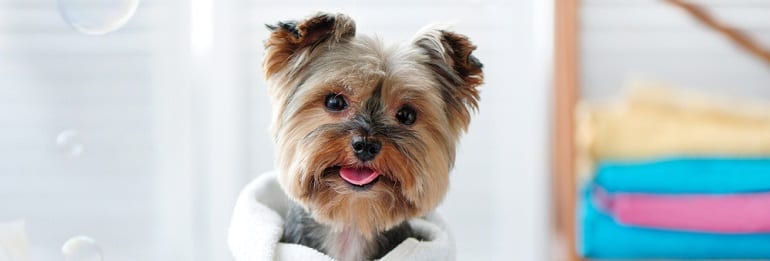If you were to poll dogs and their owners about their collective thoughts on bath time, both would probably agree that theyâd rather skip it. Unfortunately for them, periodic baths are incredibly important for a dogâs health, coat, and skin. While they also have the added benefit of making it so you can actually stand the smell and sight of your four-legged friend when it comes time to cuddle.
Like so many dog owners, youâre probably all too familiar with the difficulties of bathing your particular pooch, especially if theyâre the type that fights tooth and nail to stay out of your terrifying tub. Even if you are one of the lucky ones, with a system in place and a routine youâve nailed down, thereâs still always room to improve on bath time. Read on to discover 11 tips for dog bathing at home.
11 Tips for Dog Bathing at Home
Use the Right Shampoo
Dogs are rugged, tough creatures, capable of withstanding harsh conditions and eating things that humans could never stomach. This fact doesnât mean that you can simply give them any product that youâd also use. This goes with food items as well as pet shampoo. It may seem obvious, but many new dog owners unknowingly make the mistake of bathing their dog with soaps made for humans, often to the detriment of their pooch.
Humans and dogs have a different pH balance in their skin. Human skin is a 5 on the acid-alkaline spectrum, meaning that it is more acidic. Dogs have a 7, which is a neutral pH balance. If you were to use human shampoo, you could damage your dogâs skin and fur, often called âstripping the acid mantleâ, leaving them vulnerable to:
- Viruses
- Parasites
- Bacteria
- Dry skin
- Irritated skin
If you dog has current skin issues, a medicated shampoo might be best. Speak with your vet and ask them to recommend the right medicated shampoo for your pup. A vet will also be able to recommend a shampoo that works best with your dogâs breed, coat, and health history.
Brush Beforehand
Want baths to take less time? It helps to brush your pup before you ever get him in the water. This helps remove excess hair, dander and dirt.
This step makes your life easier and the bathing process cleaner, especially if youâre doing it in your own bath tub. It also prevents annoying and painful hair mats or knots.

When brushing, take the following steps:
- Pick a side â It doesnât matter which end you choose to start at, either the head or the tail works just fine. Simply select whichever method is more comfortable for your pup. Once you do, meticulously and gently work your way to the other end.
- Pick a brushing method â This may depend on the type of breed and its specific coat. Methods include:
-
- Brush and comb â Part the fur and use both a comb and brush to address each section in patches.
-
- Spiral brushing â Brush and comb in a circular pattern.
-
- Brush backward â Brush against the grain of the fur and then go back the other way to get it back in place. This helps to remove dead hair and dander and helps to stimulate your pupâs skin.
- Be sure to brush all of the coat â Some owners make the mistake of only addressing the top layer of the coat. You need to get at all of the hair, so itâs better to start at the skin level and then brush up and out.
Enlist Help
If you have a dog thatâs new to bathing or anxious about the experience, bring in a helper to give you an extra hand. Having someone else there who can focus on keeping your dog soothed and relaxed is a fantastic way to help facilitate the process. Especially in the early stages, your goal is to make this as positive an experience as possible. Enlisting help to provide some extra loving, might just do the trick.
Be Wary of Over bathing or accidentally leaving some soap in the undercoat
Dogs already do some of their own grooming, but periodic baths are an essential part of maintaining their health and hygiene. However, you need to avoid over bathing. Be sure to get all the soap rinsed out! Letting shampoo or conditioner dry on their coat or skin could result in skin irritation and a matted coat. It can cause several issues, including:
- Increased risk of bacterial and fungal infections
- Skin damage and irritation
- Hair follicle damage
With that in mind, certain dogs need baths more frequently than others. Frequency of baths depends on the following:
- Coat type â Different coats call for different maintenance. Dogs typically fall into one of four categories:
-
- Hairless
- Short-haired
- Medium-haired
- Long-haired
Speak with your vet to get an understanding about your dogâs coat and how often you should be washing it.
- Health â Some health conditions call for medicated shampoo and more frequent bathing practices to treat the issue. Common conditions include:
-
- Allergies
- Parasites
- Bacterial infections
- Fungal infections
- Lifestyle â Your dogâs daily activity will impact their cleanliness. An outside dog that likes to play in the dirt, mud, or water is going to end up needing to bathe more than a pup that has to be dragged from the couch.
Start âEm Young
One of the easiest tips for making dog bathing at home simple is by starting to give them baths when theyâre puppies. Dogs learn behavior, either good or bad, through repetition. By making this a routine early on, you can teach your pup that bathing is a normal and enjoyable part of their life.
Although you never want to over bathe your dog, donât space out baths too far in between one another or your pup may forget his routine and the proper expected behavior.
Prepare Beforehand
You want bathing to be as seamless and efficient as possible, right? Then you should have all of your bathing equipment close by.
- Keep a one-step shampoo +conditioner by your free hand (the hand not holding your dog in place).
- Hang the towel on the towel rack, where it can stay dry and within easy reach.
- Have treats in your pocket so you can easily cajole or reward your dog for good behavior.
- Keep a bucket near the bath in which youâll keep your brushes, combs, and any other tools you plan on using.
- Place a non-slip mat in the base of the tub. This will keep your dog from slipping and injuring themselves as they try to gain purchase.
- Block the drain with steel wool to keep dog hair from plugging it up.
Use a Tub
A bath tub is an excellent tool for corralling a restless dog. Since many pooches instantly turn into escape artists the moment the water goes on, consider using a specialized bathing leash to help safely keep them in place. If you do use a leash, make sure you never leave your dog restrained in the tub alone.

When bathing in the tub, test the water before you begin to wash your dog. Too hot or too cold could instantly sour the experience. Your goal is to make it as pleasant, relaxing, and as gentle as possible.
Protect Your Dogâs Ears
Dogsâ ears are incredibly sensitive. You want to help prevent water from entering your dogâs inner ear, which could be extremely painful. To make the bathing process as comfy as possible, carefully put cotton balls in the entryway to your pupâs ear canals. Do not shove them in! That could cause more harm than the water youâre trying to block.
Rinse Thoroughly
If you have to lather your dogâs face, tilt their head back and rinse towards the tail to ensure that the soapy water doesnât get in their eyes. Consider using a washcloth as a helpful tool.
Clean Your Dogâs Ears
Once youâve finished the bath, remove the cotton. Some dogs produce wax more often than others, but you should ideally be clearing their ears about once every other week. Leaving wax or other debris in the ear canal could easily lead to infections, so you should check them more often than you clean them.
When cleaning, you can choose to either put ear cleaner directly into the ear canal or can use cotton balls to swab the gunk away. If you go with the ear cleaner, gently massage it in, so it coats the inside of the ear. This method will prevent your pup from shaking their head to dislodge the solution.
Reward Your Dog
As the old saying goes, âif it gets rewarded, it gets repeatedâ! If your dog knows that thereâs a special treat waiting for them at the end of a bath, you can ensure that theyâre on their best behavior. As the process goes on, shower your pup with praises, pets, rubs, and love. Be gentle and methodical as you go about your tasks. Use a calm and reassuring voice so that they know not to worry. Once youâve finished your task, reinforce good bathing behavior by rewarding them with a new toy, treat, or a bone.
Benefits of Bathing Your Dog
Bathing your dog is an incredibly essential aspect of general pet care. It provides several benefits, including:
- Forging a bond â Even rambunctious pups can learn to enjoy bath time. All it takes is some training, treats, and a lot of love. Especially for puppies, bath time is your chance to teach your dog to trust you. When you reach that point, bath times become a great chance for the two of you to connect as you spend time adoring and caring for them. The repetitive motion, brushing, massaging, and warm water, all work to help your dog relax and have a blast.
- Getting rid of odors and dirt â When your dog walks into the room caked in mud and your nose picks up that heady scent of wet garbage, you know that your pupâs due for a bath. A good soak in warm water and a thorough shampoo scrub ensure that your dog will emerge from their bath, cleansed of impurities and smelling and looking great.
- Lets you stay on top of your dogâs health â Bath times are a great excuse to perform a detailed inspection of your dog to ensure their health. Youâre already up close and personal, so be sure to check for any abnormalities, irritation, bumps or discharge on their:
-
- Teeth
- Nails
- Eyes
- Ears
- Skin
Also, stay on high alert for parasites like ticks, mites, fleas, or lice.
- Softer coat â Prime moisturizing dog shampoo and a blow-dry will help your dogâs coat look lustrous, smell great, and feel soft as a cloud. Coconut oil and conditioner are worthy additions for infusing even more moisture into the fur.
- Less shedding â Regularly brushing and washing your dog will help take care of excess fur. The more frequently you do this, the less loose hair theyâll have to shed. This will help cut down on the time you spend going around your home with a lint roller or a vacuum.
- Prevents allergies â A dogâs fur is incredibly good at catching dirt, bacteria, and potential allergens. If either you or your pup have allergies, bathing frequently will dramatically help to reduce allergens being carried in the coat.
Bathing Your Pup at Home
The world would be a simpler place if your dog never got dirty or smelly. The unfortunate truth is that baths are a necessary part of keeping your dog healthy and happy. Although it may be difficult at first, with a measured and gentle approach, you can turn bath time into an enjoyable experience for both you and your pup. Follow the dog washing tips above and home baths should be a breeze.
Sources:
Cuteness. Can You Use Adult Dog Shampoo on Puppies? https://www.cuteness.com/blog/content/can-you-use-regular-dog-shampoo-on-puppies
Patrick, M. Spark People. Grooming Essentials for Dogs and Cats. (2013). https://www.sparkpeople.com/resource/wellness_articles.asp?id=1934
 Dr. Melinda J. Mayfield-Davis, DVM, WCHP-AH, brings over 20 years of experience in veterinary medicine. She is the Technical Services Veterinarian with Innovacyn, Inc., parent company of Vetericyn Animal Wellness. She received her DVM from Oklahoma State University and now resides in Southeast Kansas with her husband, two children, four dogs, and six horses. Prior to working with Innovacyn, Dr. Mayfield owned and operated the Animal Care Center in Columbus, KS.
Dr. Melinda J. Mayfield-Davis, DVM, WCHP-AH, brings over 20 years of experience in veterinary medicine. She is the Technical Services Veterinarian with Innovacyn, Inc., parent company of Vetericyn Animal Wellness. She received her DVM from Oklahoma State University and now resides in Southeast Kansas with her husband, two children, four dogs, and six horses. Prior to working with Innovacyn, Dr. Mayfield owned and operated the Animal Care Center in Columbus, KS.



